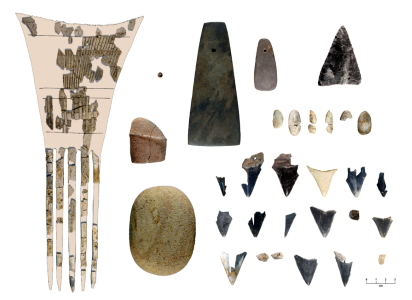Part of a series of articles titled Ancient Native Americans in Rock Creek Park.
Previous: The Quarries
Next: The Palisades
Article
At the mouth of Rock Creek, the Whitehurst Freeway ends in a tangle of ramps and embankments. This does not seem like a likely place to find a Native American camp site; if you imagine the highway under construction, with cranes, backhoes, and other heavy equipment tearing up the ground, it is easy to assume that any traces of people who once lived here must have been destroyed. Maps from the early 1900s only make this seem more likely, since they show that the area was an industrial district. But an archeological study of this area found important Native American sites, including one remarkable burial. It seems that a large amount of earth was dumped on the site before the factories were built, protecting the Indian site from the later construction of the Whitehurst Freeway.

NPS
Potsherds and stone tools found throughout the area show people camped here between 5,000 and 500 years ago. The burial that makes the site so exciting was found only a few feet from the freeway and Rock Creek and Potomac Parkway. This pit contained the cremated remains of an adult, probably a 30- to 40-year-old woman. Her scattered bone fragments had been placed in a shallow pit measuring about two feet across. Along with the bones were a comb carved from antler; two stone pendants; a carved sandstone phallus; a triangular knife; 14 great white shark teeth, 12 fossilized and two apparently recent; a bone from a large bird; six antler disks; a wooden bead; and cloth woven of fibers from pawpaw and grass. Radiocarbon dates put this burial at AD 640-790.
The Whitehurst Freeway burial closely resembles burials made in upstate New York around the same time. The resemblance is so strong that either the woman who was buried here or her parents may have come from the north. This connection is fascinating to archeologists and historians because it fits with other evidence pointing to migration from the Great Lakes region to the Chesapeake around that time. The Native Americans who lived in coastal Maryland and Virginia in the 1600s spoke Algonquian languages closely related to languages spoken around the Great Lakes. Iroquoian languages were also spoken in both regions. The Whitehurst burial reminds us that Native Americans were great travelers and that whole Indigenous Peoples sometimes moved hundreds of miles in search of new homes.
Part of a series of articles titled Ancient Native Americans in Rock Creek Park.
Previous: The Quarries
Next: The Palisades
Last updated: November 5, 2021